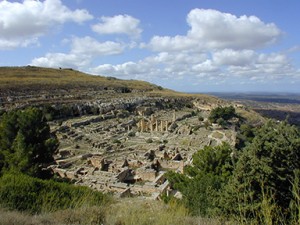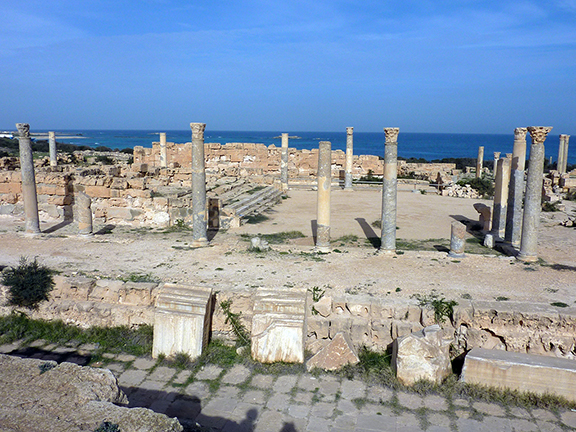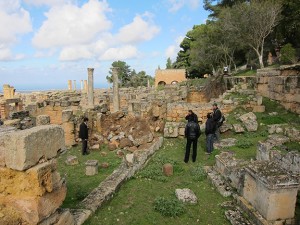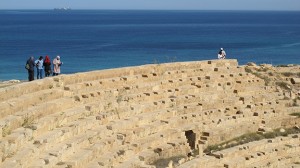By: Susan Kane and Sam Carrier, Oberlin College
The Junedestruction of an ancient necropolis near the UNESCO World Heritage site of Cyrene has drawn international attention to the precarious state of archaeology in Libya. Families living on nearby farms apparently have exerted their claim to ownership by clearing a large area of land containing the necropolis with heavy construction equipment. A section of land proposed for inclusion in the core of the World Heritage site has been entirely bulldozed.
The damage in Cyrene is not an isolated incident. Today all of Libya faces continuing significant threats and damage to its heritage sites due to unmanaged, unregulated development and civil disorder.
Since the Februaryrevolution, Libya has struggled with the challenge of building a new country. With no constitution, no clearly operating legal system, no defined property rights, and no organized police force, a major land-grab is underway in the new Libya that is causing more damage to archaeological sites than the events of theRevolution.
During the Gaddafi regime, Libya’s cultural heritage was not a priority. In the context of the challenges facing the new Libya, it is not surprising that cultural heritage struggles for recognition and support from both the government and the populace at large.
Libya’s vast landscape contains impressive cultural heritage, including five UNESCO World Heritage sites. The coastline features three Greco-Roman archaeological sites—Cyrene in the east; Sabratha and Leptis Magna in the west. Further inland, nearly 500 km to the southwest of Tripoli, is the World Heritage site of Ghadamès with its distinctive vernacular architecture. The World Heritage site of Tadrart Acacus, a massif located in the far southwest of the country, features thousands of rock-art sites, some dating as early as 12,000 BC.
American archaeological involvement in Libya began with Richard Norton, who, with the support of the Archaeological Institute of America, began the first scientific excavations in Cyrene in 1910. American work was resumed in the late 1960s by Donald White (University of Pennsylvania) but halted in 1981 due to political issues. Following resumption of relations between the United States and Libya inSusan Kane (Oberlin College) restarted work in Libya.
On our return in, we found the Libyan Department of Antiquities had suffered greatly. Under the Gaddafi regime, archaeology was of scant importance. Virtually all of Libya’s heritage sites suffered from a lack of ongoing maintenance, inadequate security, and few public programs to raise public awareness of their centrality to Libyan culture. Weak infrastructure and scanty management impeded the potential for exploitation of these heritage resources through tourism.
Asked by our old colleagues at the Department of Antiquities in Cyrene to help them, the American Mission began a series of collaborative projects—generously supported by the U. S. Embassy in Tripoli and the Ambassadors Fund for Cultural Preservation—that have focused on capacity building; the introduction of modern information technologies, new approaches to archaeological theory and practice, and courses on site documentation and mapping.
As Libya struggles to become a modern state and to shed the vestiges of the former regime, the international community has been eager to provide assistance. In OctoberUNESCO convened in Paris an international meeting of experts on Libya heritage. The group expressed their concern about the fragility of Libyan cultural heritage and risks to it in the aftermath of the conflict and during the transition to a new government. Their recommendations focused on: securing heritage sites and collections, strengthening the legal and institutional framework for heritage, and increasing the awareness of and support for heritage by the national and local publics within Libya. A variety of measures were recommended to achieve these goals that included a moratorium on excavations and similar research initiatives. Rather, the missions were encouraged to assist Libya with the protection, assessment, documentation, and management of cultural heritage. This was to be realized through a focus on training to contribute to the strengthening of Libyan management capacity. After years of neglect, the rehabilitation of the Department of Antiquities will be a long term, ongoing project.
Under the previous regime the Department of Antiquities was under the jurisdiction of various ministries, in particular Tourism and Education. It is now housed within the newly created Ministry of Culture and Civil Society, headed by Habib Al-Amin, who is an archaeologist.
During our seven trips to Libya since theRevolution we have found increasing signs for new public interest in Libya’s cultural heritage. Various non-governmental organizations are forming as well as a variety of independent media—broadsides, newsletters, newspapers, radio stations, and others. Facebook pages abound. Ideas are freely exchanged with vigor in all sorts of venues.
But the Libyan struggle, to reconstitute itself into a modern state, presents daunting challenges. For forty-two years, individual behavior was constrained not by adherence to written laws but by the forceful hands of a totalitarian state overlaying the customs of strong and proud tradition of tribalism. The top down direction of the socialist state shaped lackadaisical work habits and squashed individual initiative. As one of our friends said: “we’ve had forty-two years behind our necks.”
The nascent government of the new Libya is responding to issues slowly. Financial resources are not flowing readily. Human resources, particularly in the areas of planning and management, need to be fostered and developed.
Today Libyan archaeology is inaccessible to tourists (Libya does not currently issue tourist visas). Since the Revolution, museums remain closed countrywide.
Security remains problematic. Without a secure police force, regional controllers are hesitant to have their archaeologists conduct fieldwork or site inspections in areas deemed to be unsafe. As noted above, local people are moving fast to claim land and to build houses in this time of legal limbo. Ironically, the area of the destroyed necropolis was mapped and documented by Department of Antiquities personnel during an American Mission training course in May. Two steps forward, one step back.
So where does archaeology and cultural heritage stand in the new Libya? For the moment it is tentatively rebuilding. Its immense potential will one day be realized. That is inevitable. But how soon, that is the question.
Susan Kane is Professor of Classical Archaeology at Oberlin College. Inshe received the Society for American Archaeology’s President Award for her work protecting Libyan cultural heritage. Sam Carrier is Associate Professor of Psychology at Oberlin.
~~~
All content provided on this blog is for informational purposes only. The American Schools of Oriental Research (ASOR) makes no representations as to the accuracy or completeness of any information on this blog or found by following any link on this blog. ASOR will not be liable for any errors or omissions in this information. ASOR will not be liable for any losses, injuries, or damages from the display or use of this information. The opinions expressed by Bloggers and those providing comments are theirs alone, and do not reflect the opinions of ASOR or any employee thereof.






